As an Amazon Associate, I earn from qualifying purchases.
An easy step-by-step tutorial on Canning Peaches. This recipe for how to preserve peaches is perfect for beginners and experienced canners alike. Instructions include low-sugar and no-sugar options.

Peaches are one of the easiest fruits to can. Sure, you have to peel them, but that can be accomplished fairly easily.
Even better, I’m going to teach you how to make canned peaches in light syrup, so you can actually taste the fruit and not just sugar. Need no-added-sugar options? We’ve got those too!
And if you decided that peach preservation is just not for you, check out our peach freezer jam, peach butter, and our tutorial on how to freeze peaches. All use delicious fresh peaches without canning.
How to Can Peaches
*I’ll walk you through it here with some photos and tips, and you’ll also find a printable recipe card at the bottom of the post with exact measurements, etc. You can also click “jump to recipe” to skip down.
CANNING PREP
Prepare your water bath canner by filling it with water. You need to have enough water to cover the jars by 1 inch once the water is boiling.
Set the canner on the stove. Turn the burner to high. Once it reaches a boil, reduce it to a simmer. You want to keep the water hot so that everything is ready when the fruit is.
Wash and clean your jars. You’ll want to keep them warm to avoid having them crack when placed in the canner. You can fill them with hot water, or place them on a tray in the oven at 170˚F.
Wash your lids and set them aside in a clean place. You no longer need to simmer lids in water to keep them sterile. Woot!
Wash your fruit. I just run them under water and rub my hands on them to give the outside a scrub. Use a paring knife and cut the peach around the middle to separate it.
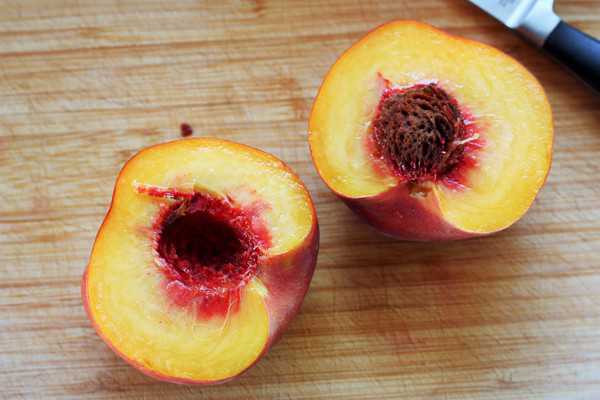
Remove the pit
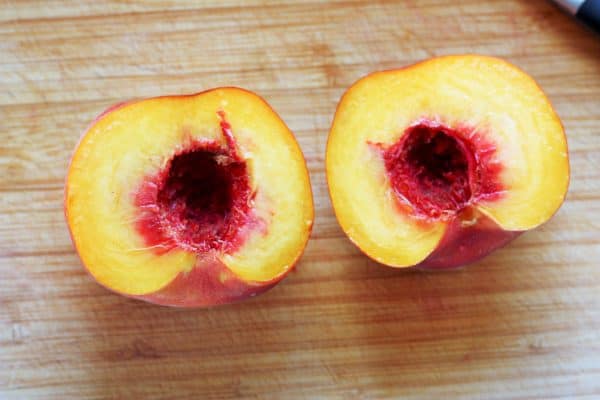
Put the halves in a large bowl of water treated with lemon juice or citric acid.
Blanching Peaches
Add one layer of peaches at a time to a pot of boiling water for about 60 seconds. Once you can see the skin starting to come away from the flesh, it’s time to take them out.
Remove using a slotted spoon and place in an ice bath for 1 minute.
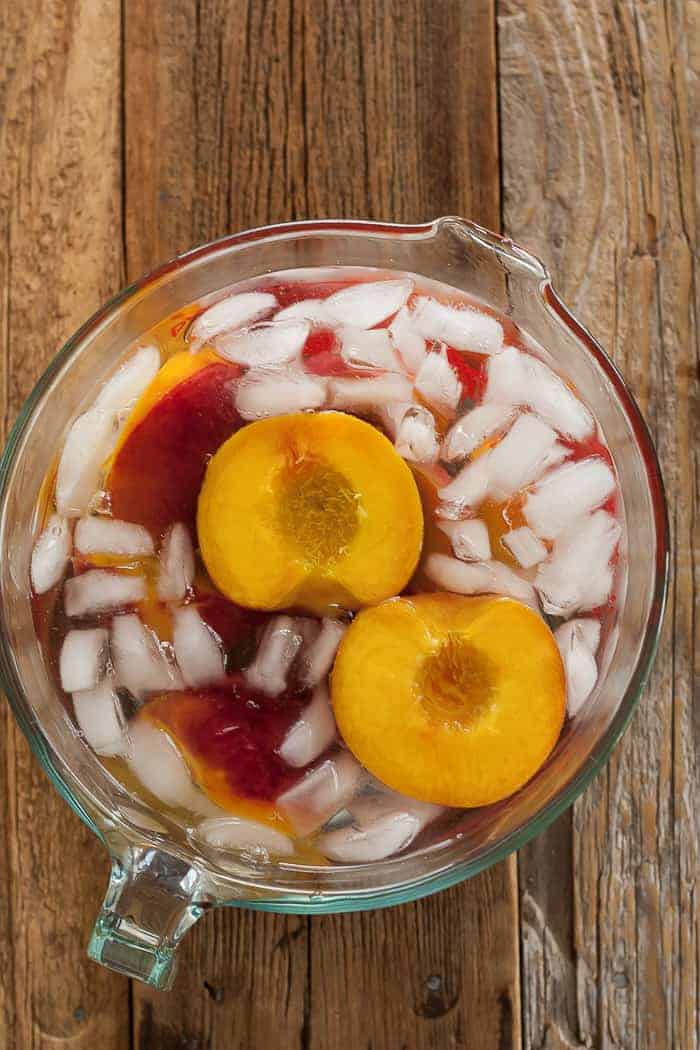
Use the slotted spoon to remove the peaches from the ice bath. Grab one and gently peel the skin back.
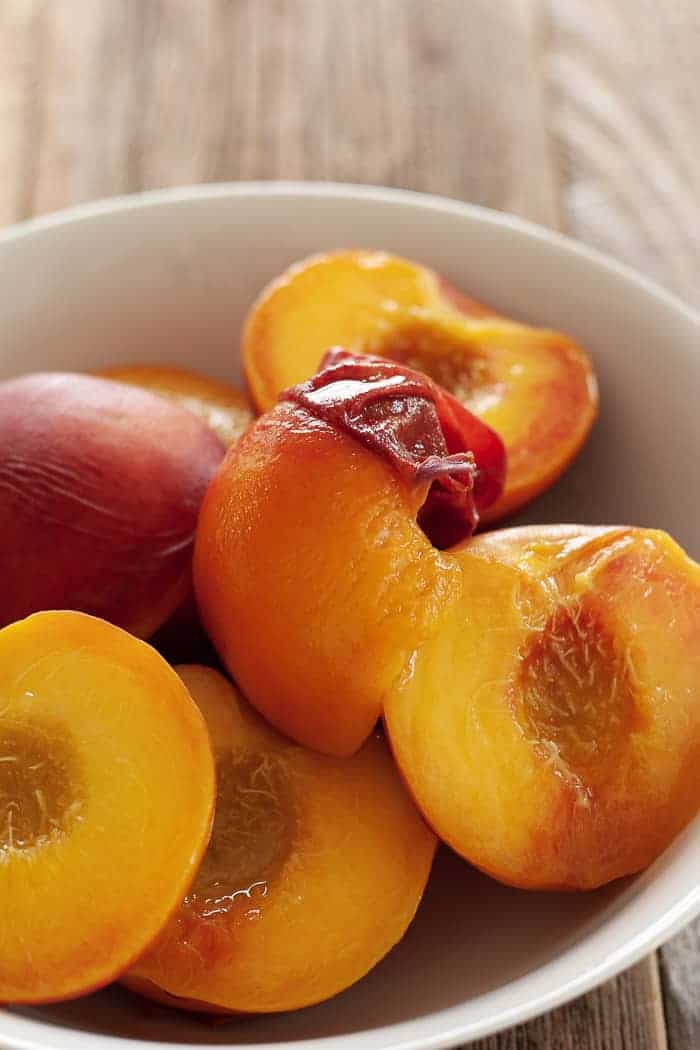
Syrups for Canning Peaches
If you prefer a no-sugar option, peaches can be canned using only water. But if you plan to can your peaches with sweetener, you can use sugar, honey, or fruit juice (apple or white grape). You’ll also want to decide how sweet you want the syrup to be.
In a medium-sized pot, combine your sugar/honey/or juice, and water to create the syrup. See the cheatsheet below as a guideline for making syrup:
Syrups for Canning
| Syrups for Canning | ||||
| Type of Syrup | Sweetener | Amount of Sweetener | Water | Yield |
| Very light | Sugar | 1 cup | 6 cups | 5 3/4 cups |
| Light | Sugar | 2 1/4 cups | 5 1/4 cups | 6 1/2 cups |
| Medium | Sugar | 3 1/4 cups | 5 cups | 7 cups |
| Heavy | Sugar | 4 cups | 5 cups | 7 cups |
| Honey | Honey | 1 cup | 4 cups | 4 1/4 cups |
| Juice | Apple or white juice concentrate | 1 1/2 cups | 4 1/2 cups | 6 cups |
| *Source: National Center For Home Food Preservation | ||||
Pro tip: if you plan to process multiple batches of peaches in a day, make the syrup and transfer it to a slower cooker set to “high”. This will keep the syrup hot while freeing up space on your stove.
Raw Pack For Canning Peaches
Raw packing simply means placing the peeled peaches in the jars without pre-cooking them, filling the jars with hot syrup, and processing them in the canner.
If you are canning your peaches without additional added sugar (sugar, honey, fruit juice), you must hot pack the fruit.
Raw packing is much faster than then a hot packing process, but there are some drawbacks. No matter how well you pack the jars, the density of the fruit will change during their time in the canner.
This often leads to something called “fruit float” in which the peaches will float to the top of the jar, leaving all syrup on the bottom. There is nothing wrong with fruit float as long as your jars are still sealed.
You’ll find this when you’re canning pears, canning apricots, and canning whole tomatoes as well.
To raw pack the peaches, add the fruit cavity-side down (where the pit was) to your sanitized and warm canning jars. This is easiest done with a fork. Repeat with other peach halves until you have filled the jar. Then, ladle hot syrup over the top of the peaches. Pro tip: depending on the size of the fruit, each quart will fit about 3-3.5 peaches.
Hot Pack For Canning Peaches
Hot packing involves cooking the peaches briefly in hot syrup before packing the peaches into jars for canning.
You’ll want to boil the peach halves in the canning syrup for about 2 minutes and then add them to your jars, ladling more hot syrup over the top.
The appeal of hot packing are that you typically can fit more fruit per jar, and the near elimination of fruit float.
Canning The Peaches
At this point, return your water in the canner back to a rolling boil.
Using a canning funnel, ladle hot syrup into the jars, leaving 1/2 inch headspace. You may need to use a spoon to gently smoosh down the fruit a bit.
Using a long utensil (I prefer a plastic chopstick), remove all the air bubbles from the jar. Clean the rim of the jar very well with a hot damp rag. Place a clean lid on the jar. Add a ring, and tighten to fingertip tight.
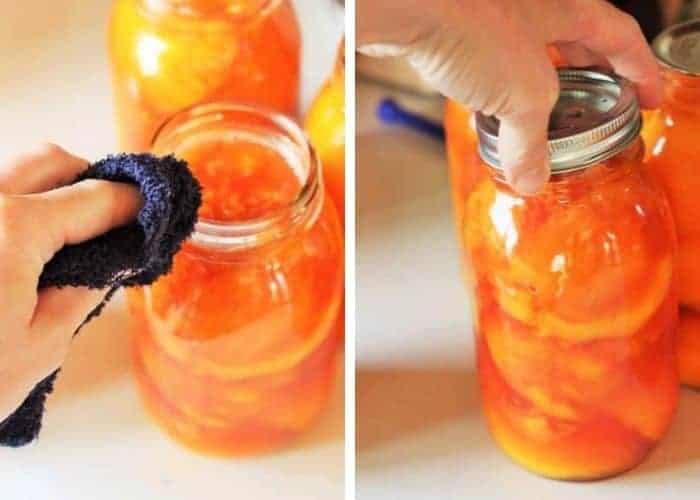
Using canning tongs, carefully place your jars in the canner. Put the lid on. Processing times will vary based on altitude. See the chart below.
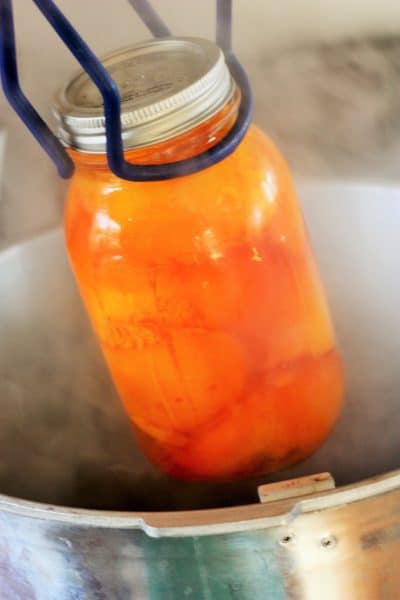
PROCESSING TIME FOR Canning Peaches
Pro tip: the water must return to a boil in the canner before you can start the timer.
Processing Time for Peaches
| Processing Time for Peaches | |||||
| Process Times at Altitudes of: | |||||
| Style of Pack | Jar Size | 0-1,000 ft | 1,001-3,000 ft | 3,001-6,000 ft | Aove 6,000 ft |
| Hot | Pints | 20 min | 25 min | 30 min | 35 min |
| Quarts | 25 min | 30 min | 35 min | 40 min | |
| Raw | Pints | 25 min | 30 min | 35 min | 40 min |
| Quarts | 30 min | 35 min | 40 min | 45 min | |
| *Source: National Center For Home Food Preservation | |||||
Once the jars have been processed for the appropriate amount of time, remove the canner from the burner, wearing oven mitts carefully take off the lid of the canner, and allow it to sit for 5 minutes. Pro tip: I tend to just slide the canner into the middle of my stove, as it weighs a ton.
Carefully remove the jars with canning tongs, and place them on a thick towel in a place where they can be undisturbed for 12 hours.
The lids will likely start to pop within 20-30 minutes of being removed from the water. That popping sound is music to your ears, as it tells you that everything has been sealed. It’s a reward for all your work!
After the jars have rested for about 12 hours, press down in the middle of each lid. If it “gives” at all, the jar didn’t seal. Either enjoy it that day, put it in the fridge, or reprocess it.
Pressure Canning Peaches
If you prefer to pressure can your peaches, follow the prep and packing process above and the canning process below.
Add 3 quarts of water to your pressure canner and put it on a burner set to high. Make sure there is a canning rack in the bottom of the canner.
Using canning tongs, gently place the jars in the canner. Lock the lid. Soon, steam will start coming through the vent pipe (I call it the steam chimney).
Allow the steam to pass through for about 10 minutes. Then put the pressure regulator (I call it the chimney cap) on top. (see the 4 photo grid below for a visual of this process step by step)
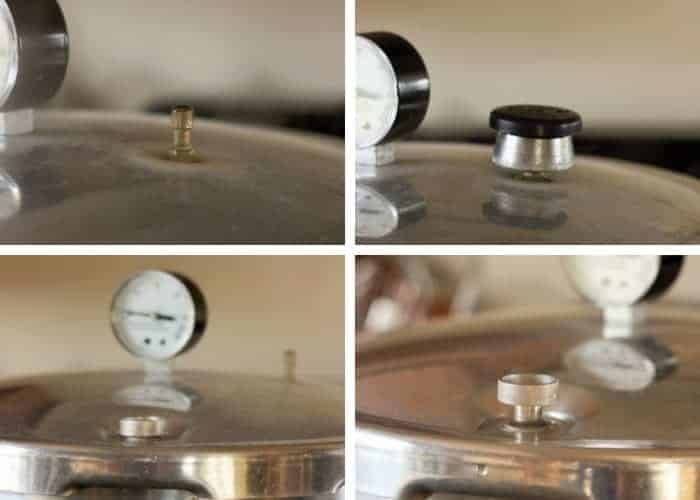
Pretty soon, the air vent will pop up. That is a sign that you’re starting to build pressure inside the canner (get excited. This is happening!). Processing times will vary based on altitude. See the charts below.
Pressure Canning Peaches in a Dial-Gauge Pressure Canner
| Canner Pressure (PSI) at Altitudes of | ||||||
| Style of Pack | Jar Size | Processing Time | 0-2,000 ft | 2,001-4,000 ft | 4,001-6,000 ft | 6,001-8,000 ft |
| Hot or Raw | Pints or Quarts | 10 min | 6 lbs | 7 lbs | 8 lbs | 9 lbs |
| *Source: National Center For Home Food Preservation | ||||||
Processing Time for Peaches in a Weighted-Gauge Pressure Canner
| Canner Pressure (PSI) at Altitudes of: | ||||
| Style of Pack | Jar Size | Processing Time | 0-1,000 ft | Above 1,001 ft |
| Hot or Raw | Pints or Quarts | 10 min | 5 lb | 10 lb |
| *Source: National Center For Home Food Preservation | ||||
When the dial gauge reaches the appropriate PSI, reduce the burner temp to medium, and start your timer. The pressure must stay at the PSA or (a little bit) above for the duration of the cooking time. You’ll likely need to adjust the temp on the burner a few times depending on your stove.
When the time is up, remove the canner from the burner and allow it to sit until you hear a distinctive “click” of the air vent dropping. Remove the pressure regulator and carefully remove the lid of the canner (Pro tip: I always use oven mitts when I take the lid off because the steam is super hot).
Let the jars sit for 5 minutes in the canner with the canner lid off and then lift them out with canning tongs. Pro tip: allowing the jars to sit in the canner with the canner lid off can help reduce the siphoning of liquid in your jars.
Place hot jars on a towel where they can sit undisturbed for 12 hours.
After a few hours, to check for sealing, gently press down in the middle of the lid. If the lid has no give, it’s sealed. If you can press the lid in and it pops a bit, your jars are not sealed.
STORAGE FOR HOME CANNED Peaches
Once the jars have sealed, remove the rings. Label and store sealed jars in a cool (best results are 50-70˚F) dark place for up to 12-18 months.
If you have the space available, do not stack the jars on top of each other more than two jars high.
Help! Why Are My Jars Leaking Juice?
If you find that juice has leaked out after they have sealed, you have experienced a common canning issue called siphoning. It happens to the best of us!
Siphoning is typically caused by not allowing the jars to rest in the canner after they have finished processing. In the directions above, you’ll see that I recommend you remove the canner from the burner, remove the lid, and let it sit for 5 minutes.
This is important as it allows the jars time to rest before being allowed to cool on the counter. Doing this process will significantly cut down on siphoning.
If you have siphoning in your jars, follow these steps:
- Check – are the lids still sealed?
- Look – have you lost less than half of the amount of liquid in the jar?
- Examine – does the fruit look fresh with bright colors?
If the answer to the above three steps is “yes!”, then they are safe to eat. If you lost quite a bit of syrup, the uncovered fruit will turn color more quickly. Plan to eat those jars first.
What if my jars don’t seal?
If you’ve correctly processed your fruit, and the lids still didn’t seal, you can reprocess them.
Double-check to make sure there are no:
- Chips in the rim of the jar
- Dried syrup or bits of peach on the rim (anything between the rim and the lid may prevent a seal.
Best practices would involve using brand-new lids for reprocessing. Set aside the old lids to use for dry storage.
If the jars don’t seal on the second attempt, you likely have a bad batch of lids, or your canning process has a step missing. Email me and we’ll try to troubleshoot what is going on.
For unsealed jars, you can place them in the fridge. Eat the fruit within three weeks.
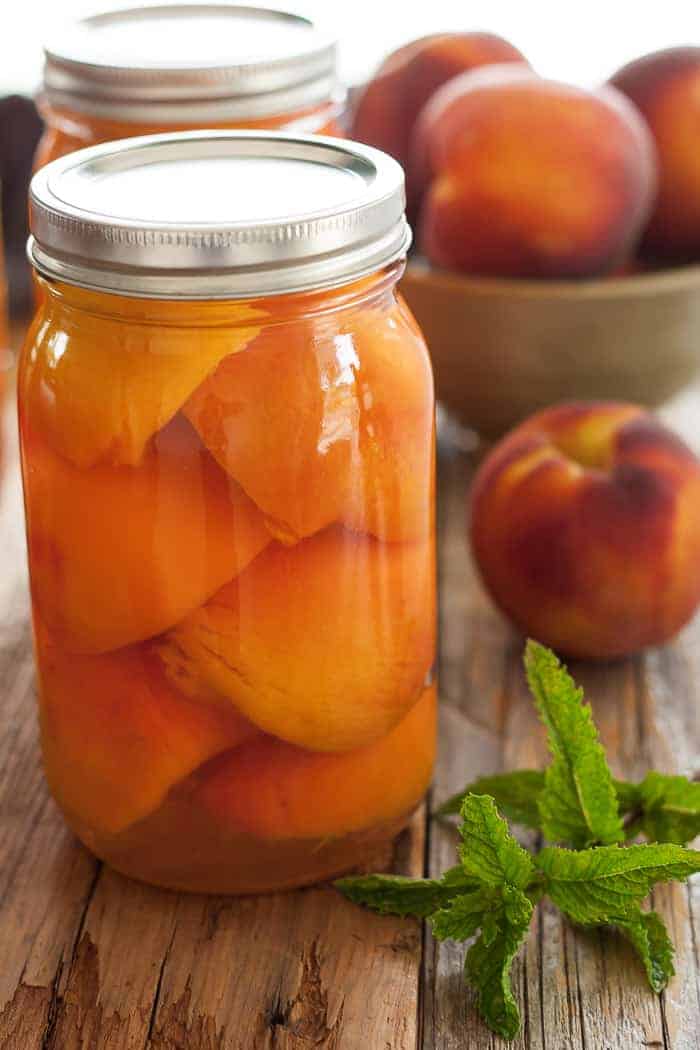
Can I make canned peach slices?
Yes! If you’d prefer to cut your fruit into slices, that is absolutely fine. Think about how you plan to use them after canning. Do you want to eat them as is? If so, halved peaches will be the easiest and fastest way to can them.
Pro tip: with canning peach slices, you’ll need to put a bit more effort into removing bubbles from the jars. There will be more opportunities for “pockets” to occur in the jars, and those bubbles need to be removed for safety.
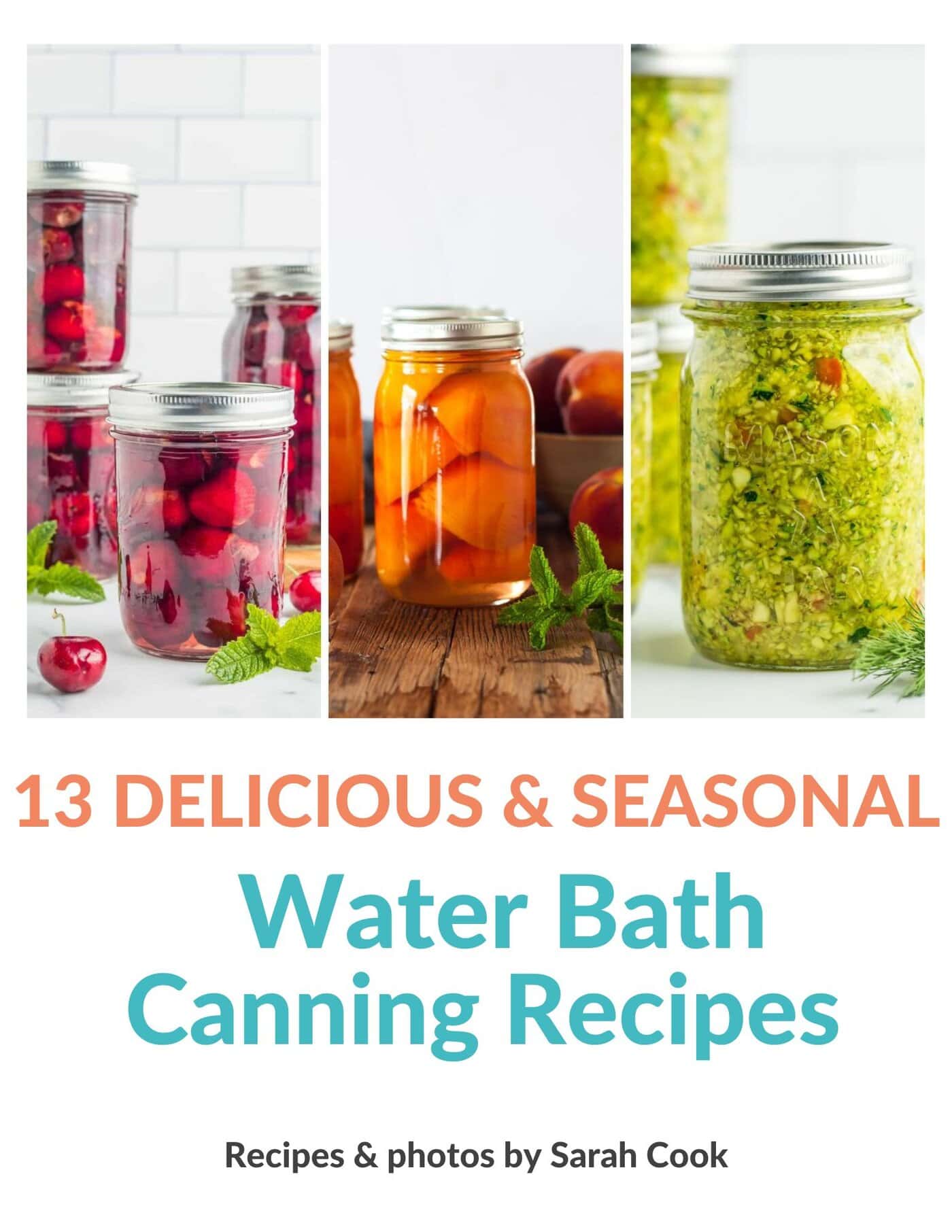
Get my Canning e-book!
It’s 51 pages of every helpful tip and trick you could want as a brand new canner, AND it includes 13 ad-free canning recipes that are designed to take you from novice to pro.
Canning Peaches (Whole, Halves, or Slices)
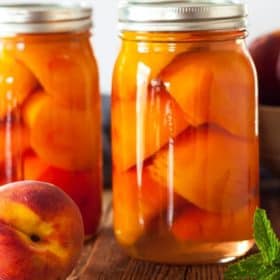
Equipment
Ingredients
- 17 lbs peaches
- 1/4 cup lemon juice
- 6 cups water {+more for the canner}
- 1 1/2 cups sugar
- ice
Instructions
Canning Prep
- Prepare your water bath canner by filling it with water. You just need to have enough water to cover the jars by 1 inch once the water is boiling.
- Set the canner on the stove. Turn the burner to high. Once it reaches a boil, reduce it to simmer. You want to keep the water hot so that everything is ready when the peaches are.
- Wash and sanitize your jars. You’ll want to keep them warm to avoid having them crack when placed in the canner. You can fill them with hot water, or place them on a tray in the oven at 170˚F.
- Wash your lids and set aside in clean place.
- Use a paring knife and cut the peach around the middle to separate. Remove the pit. Put the halves in a large bowl of water treated with lemon juice (~1/4 cup) or citric acid (1 tbsp).17 lbs peaches, 1/4 cup lemon juice
Blanching Peaches
- Fill a large mixing bowl with ice water. Set aside.ice
- Add one layer of peaches at a time to a pot of boiling water for about 60 seconds.
- Remove using a slotted spoon and place in the ice water for 1 minute.
- Use the slotted spoon to remove the peach halves from the ice bath. Grab one of the peaches and gently peel the skin back.
Canning Peaches
- Combine water and sugar in a medium saucepan. Bring to a low boil and fully dissolve the sugar. See the chart in the post above for different levels of syrup.6 cups water, 1 1/2 cups sugar
- (Hot Pack Method) Once the syrup is boiling, add the peach halves one layer at a time (a canning term that means don’t totally fill the pot) and heat for 2 minutes.
- (Hot pack option) Using a fork and canning funnel, grab the now softened peaches, add the peach halves, one at a time, and put them cavity-side (where the pit was) down in the canning jar.
- (Hot pack option) Repeat with other peach halves until you have filled the jar. Pro tip: depending on the size of the peaches, each quart will fit about 3-3.5 peaches.
- (Hot pack option) Using a canning funnel, carefully ladle hot syrup into the jars, leaving 1/2 inch of headspace.
- (Raw pack option) Using a fork and canning funnel, place peaches cavity-side down in the canning jar.
- (Raw Pack Option) Using a canning funnel and a ladle, fill each jar with hot syrup or water, leaving 1/2 inch of headspace. Headspace is the distance between the top of the food and the top of the jar.
- At this point, return your water in the canner back to a rolling boil.
- Using a long utensil (I prefer a plastic chopstick), remove all the air bubbles from the jar.
- Clean the rim of the jar very well with a hot damp rag.
- Place a clean lid on the jar. Add a ring, and tighten to fingertip tight.
- Using canning tongs, gently place your jars in the canner. Put the lid on, and set your timer. Pro tip: the water must return to a boil in the canner before you can start the timer.
- Process HOT PACK pints and quarts based on the elevation guide below:*0-1,000 ft – Pints =20 min Quarts =25 min*1,001-3,000 ft – Pints =25 min Quarts =30 min*3,001-6,000 ft – Pints =30 min Quarts =35 min*6,000 ft+ – Pints =35 min Quarts =40 min
- Process RAW PACK pints and quarts based on the elevation guide below:*0-1,000 ft – Pints =25 min Quarts =30 min*1,001-3,000 ft – Pints =30 min Quarts =35 min*3,001-6,000 ft – Pints =35 min Quarts =40 min6,000 ft+ – Pints =40 min Quarts =45 min
- Once the peaches have processed for the appropriate amount of time, remove the canner from the burner, and carefully remove the lid of the canner (Pro tip: use oven mitts to take the lid off because the steam is super hot).
- Using canning tongs, carefully remove the jars, and place them on a thick towel in a place where they can be undisturbed for 12 hours.
- After the jars have rested for about 12 hours, press down in the middle of each lid. If it "gives" at all, the jar didn't seal. Either enjoy it that day, put it in the fridge, or reprocess it.
Notes
- If you’re planning to can multiple batches of peaches all at once, I use my crockpot to create and keep the syrup hot. It frees up space on the stove.
- Once the jars have sealed, remove the rings. Label and store sealed jars in a cool (best results are 50-70˚F) dark place for up to 12-18 months.
Nutrition
Nutrition information is automatically calculated, so should only be used as an approximation.
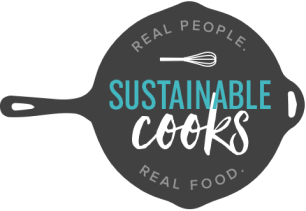

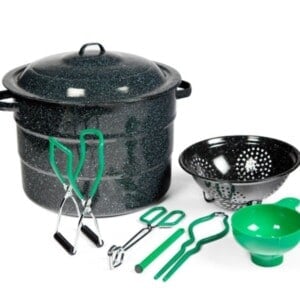
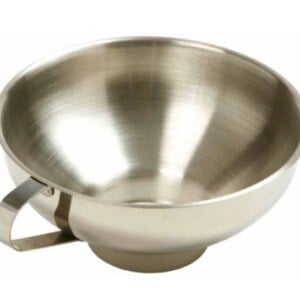
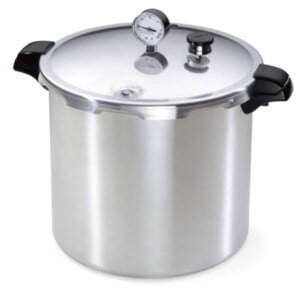
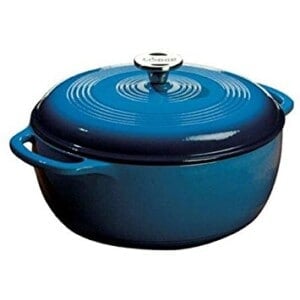
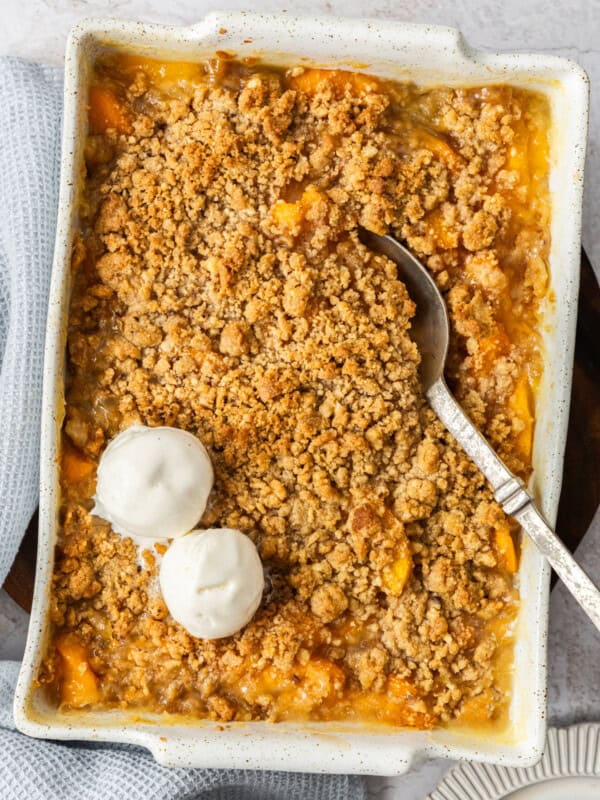
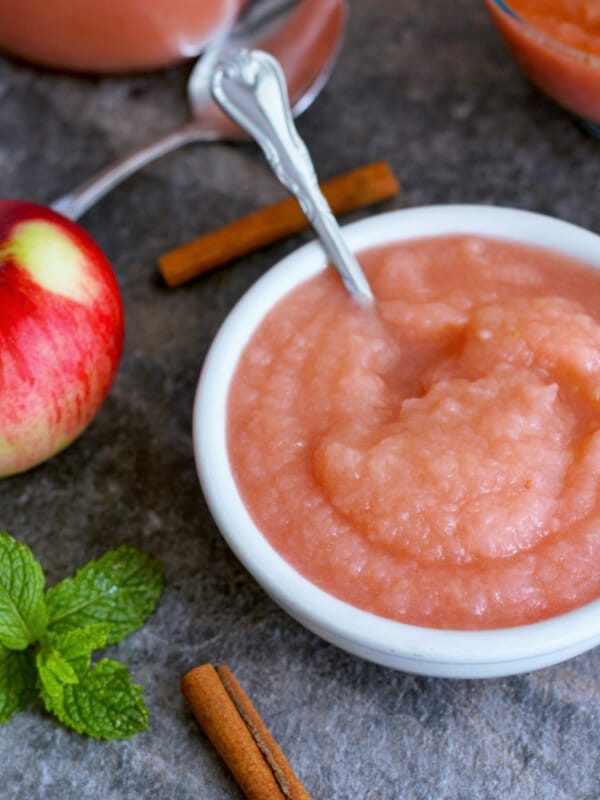
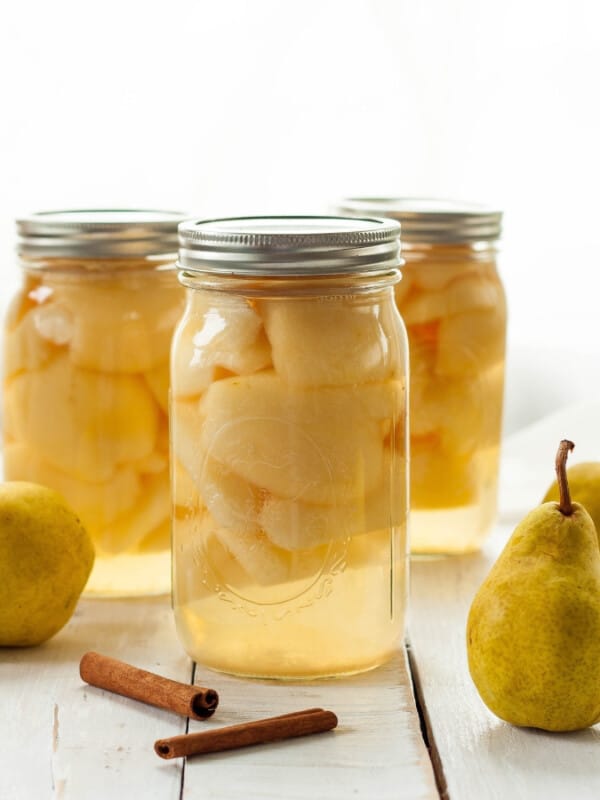
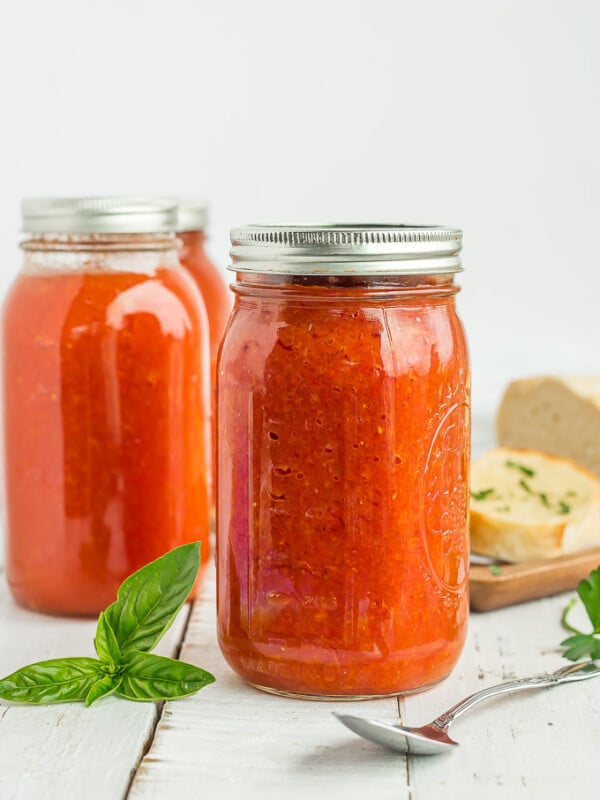
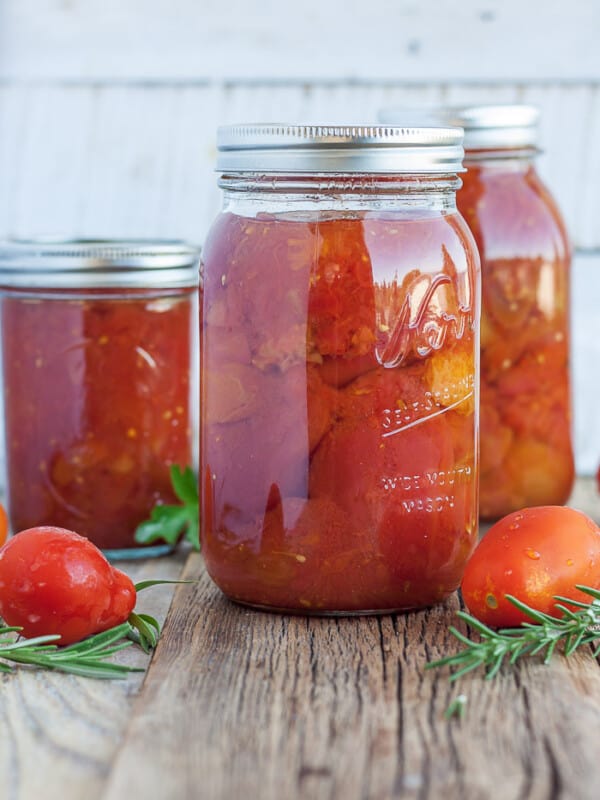
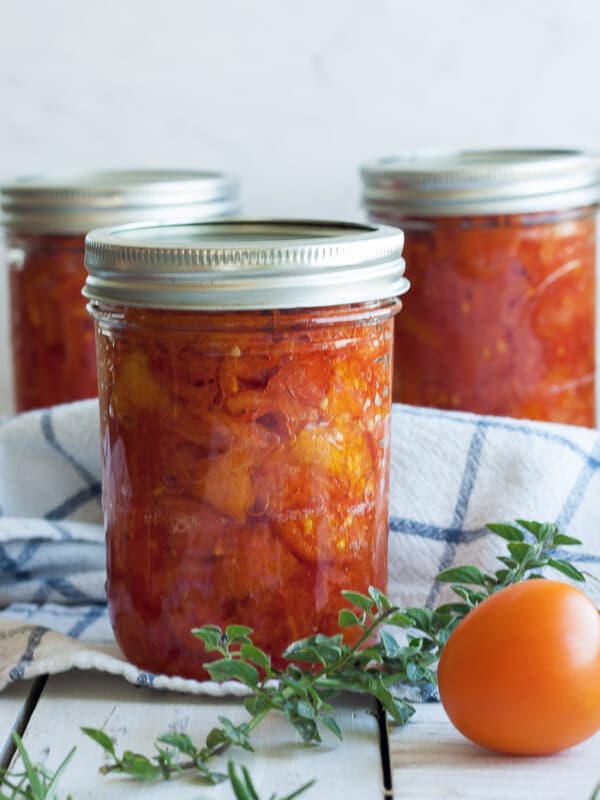






Can cinnamon be added to this recipe?
Hi Sarah, yes you “can”! <---canning joke I would use cinnamon sticks rather than ground cinnamon. There is nothing wrong with ground cinnamon, but unless you dissolve it in the syrup, it's going to look off in the jars.
Hi,Sarah, When do you add the lemon juice to the peach canning process?
Hi Judi, it’s used in the prep of the peaches. To keep them from browning. If you look at the printable recipe card, it’s under “Canning Prep” and step 5. I’m going to copy and paste it below but the formatting might not come through. Apologies in advance if it shows up wonky.
Use a paring knife and cut the peach around the middle to separate. Remove the pit. Put the halves in a large bowl of water treated with lemon juice (~1/4 cup) or citric acid (1 tbsp).
17 lbs peaches,1/4 cup lemon juice
Thank you, Sarah.
My pleasure and happy canning!
Question, I have about 30 pounds of Freestone peaches, some have some bruises, most are small bruises, can I still them with some bruising?
Hi Bob, yes, but I would cut the bruising out before canning them. It may be easier to can them as a slices if the bruising is a lot and would impact the overall size of the halves.
This has been so helpful! 2 questions though: I don’t think I made my first batches as hot packed as they could have been I.e. slight simmer for 3 min instead of 2 min hard boil with a mixture which was part fruit juice, is that okay? Also, I fiddled with the lids to see if they were sealed within minutes of taking them out of the water bath canner (I’m an inpatient and curious person 😜), they seemed to have sealed, but could I have made them “fake” the seal somehow?
Hi! First off, with the packing, that’s totally fine as long as they processed in the canner for the correct amount of time. Hot pack vs raw pack doesn’t matter in terms of safety. It’s all about that proper processing time.
Second question, how did you fiddle with the lids? Were you trying to remove them? Push them down? If you were pushing them down before they were ready to seal, they would likely pop right back in the middle. When you go to open one (in a few days, next week, etc.,) as long as they make an unsealing sound (you would laugh at how many times I just attempted to type what I though the sound would be like in words), you’re good. You can’t really force seal a jar before it’s ready to.
Happy canning, Eowyn!
I have a question….I think I followed your recipe exactly, but I have a lot of liquid loss after canning. I processed them for 30 mins and left them in the canner for 5, like you suggest, however some of my jars lost 1/4 of their liquid maybe? Are they still ok? What can I do the next time to prevent this? Thanks!
Hi Teresa, what is your altitude, what size jars did you use, and did you use the raw or hot pack method? Those answers will help me help you figure this out for next time.
That being said, what you’re experiencing is called siphoning. I have a section in the post about it and it has a checklist of three things to figure out if your peaches are still safe to eat. I’m going to copy and paste it here so that you don’t need to hunt for it. Apologies in advance if the formatting comes across as weird.
IF YOU HAVE SIPHONING IN YOUR JARS, FOLLOW THESE STEPS:
Check – are the lids still sealed?
Look – have you lost less than half of the amount of liquid in the jar?
Examine – does the fruit look fresh with bright colors?
If the answer to the above three steps is “yes!”, then they are safe to eat. If you lost quite a bit of syrup, the uncovered fruit will turn color more quickly. Plan to eat those jars first.
Is this recipe able to be used for mandarin oranges as well?
Hi Morgan, no, this cannot be used for mandarin oranges. I do not have a tested recipe for oranges.
Thank you for all the great, easy canning recipes. I am canning for the first time this summer, and your site has made canning less intimidating. We will be enjoying peaches all winter.
Carolyn, I’m so glad I could be a part of your journey to become a canner!
I ot packed my peaches, but I still have significant fruit float. Can you tell me why? Can you also tell me how to resolve it?
Hi Kendra, there could be a few reasons and without being in your kitchen, it’s hard to know for sure. 1) the peaches could have been incredibly dense/ripe 2) if you’re new to canning, you may have underpacked the jars, giving the peaches too much room to stay in place, 3) the syrup you were using to hot pack may just not have been hot enough.
If any of those above happened, fixing those things would improve fruit float next time. That being said, even after years of canning, I still get some fruit float with peaches and pears. It’s not bad or dangerous from a food safety standpoint.
Is it alright to use a sugar substitute? My husband & brother are diabetics
Sandra, would they be able to handle honey, maple syrup, or fruit juice? My grandpa was diabetic and I remember he was able to consume honey because of the absorption rate.
That being said, you can actually can the peaches without any sugar at all if you’d prefer. I did find this trusted resource for canning with alternative sweeteners.
You didn’t mention anything about when to add the lemon juice or citric acid… I was told by my fb canning group that you always have to have sugar and an acid to preserve peaches properly… but you said in your article that you can can with just water and no sugar… So now I’m very confused.
Hi Kate, the lemon juice or citric acid is used to prevent the peaches from turning brown while you’re cutting them. It’s noted in the printable recipe card, in step 5 under the heading “Canning prep”. I’ll copy and paste it below:
Use a paring knife and cut the peach around the middle to separate. Remove the pit. Put the halves in a large bowl of water treated with lemon juice (~1/4 cup) or citric acid (1 tbsp).
Peaches (and almost ALL fruits) have enough natural sugar to not need added sugar. Acid is needed to balance produce that doesn’t have enough natural sweetness for plain canning, such as tomatoes. You’re able to can pears, apricots, and applesauce without any sugar added because they contain enough natural sweetness.
That being said, I do note that a bit of sugar is better for a longer-shelf life and a more desirable color. At the end of the day, the choice is up to you if you want a bit of sugar or not. I typically do 1 cup of sugar per 6 cups of water for an ultra-light syrup.
Great recipe and easy to follow. Thanks! I tap the jars with the peaches and syrup lightly on my cutting board to remove all air bubbles. Works like a charm!
Great tip, thanks Randi!
Good morning, thank you for your recipe. I can’t say a mature canner, but I’ve never seen a recipe for canning peaches that cuts the peach in half and remove the seed, prior to blanching. Which I understand would be much easier to remove the seed, but wonder if blanching a peach cut in half affects the flavor of the peach. Also, if you roll the cut peaches around in the lemon water, than blanch, doesn’t the purpose of the lemon be negated? I’m not trying to challenge your recipe, just curious and if cutting and deseeding prior to blanching works without affecting the flavor of the peach, I’m all in! Thank you.
I’ve done it both ways Debra, and the taste is the exact same. So for me, the easy does it way wins. 🙂
The lemon water comes into play if you’re cutting A LOT of peaches and want to do them all at once. If you’re fast or have help, you can skip this part. But for me, I like to do a huge batch of slicing, then peeling, then canning at once. My own little mini assembly line.
Thank you for your article, I did see a type of tea called peach tea that tastes very good, could you provide instructions on how to make it?
Unfortunately, I haven’t made peach tea before so I would not be the best resource for that recipe.
I’m trying to get the peaches to peel upon blanching and can’t get them to the place where it’s easy to pull the peels off. Is that that my peaches aren’t ripe enough? Could I see one of those
It definitely sounds like they aren’t ripe enough.
I’m unclear about your question “could I see one of those”? Do you mean what an unripe peach trying to be peeled looks like?
So far I have only read up to “Don’t do this barefoot, your back will hate you”. OMG where were you 2 days ago LOL. I am new to this whole canning thing. I enjoy gardening and had a bumper crop of tomatoes which I didnt want to go to waste. Then it expanded to the fruit we picked at a local farm and thats where I stood for way too long and geez. The next day I could barely move my lower back was so sore. So, shoes– got it. Thank you!
No shoes = big big problem!! The good news is you learned your lesson and you’ll have supportive footwear in the future. 🙂
Easy recipe with great results. Honey syrup will impart a strong honey taste, while sugar syrup offers more of the peach taste. Both are good. If cutting peaches into into wedges then cook in syrup first to reduce the amount of fruit-float from canning; simmer in solution for 5 minutes. Use Baby Gold or another “cooking peach” so they can stand up to heat of canning and cooking in syrup.
Glad you enjoyed it, Joe! Happy canning.
How ripe should peaches be for canning?
Ripe enough that you’d want to eat them as a snack. If they’re too hard they will soften up while canning but they won’t be as tasty.
I just canned my first batch of peaches. Should I be concerned about tiny bubbles in one of my jars? I tried to be very careful about getting the air bubbles out with a chopstick prior to putting the lids on.
The tiny bubbles are usually perfectly fine/safe. If you’d like to email me a photo at [email protected] just to be extra sure, I’d be happy to take a look.